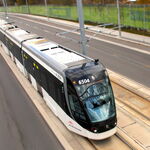V: Toronto-Kitchener-London vs Toronto-Burlington-London
I forgot about the old track bed that goes north of Brantford. Great idea! So express trains can bypass Brantford altogether and local trains can go on the existing CN tracks. This reduces the need for elevated crossings in Brantford. GO Transit could also rent out the new tracks to CN (signficantly speeding up CN trains throught the area).
I would also consider just west of Woodstock to transfer the line to the CP tracks (they run within 100m of each other for about 1 km with a field seperating them). CP Tracks west of Woodstock are very straight and run right beside the London Airport. This would shave I'm guessing 5 minutes from the time.
In London at Dundas and Highbury the St Mary's and CP lines cross and it would not be difficult to add a junction if the existing VIA station is where the train wants to terminate.
From a pure benefit standpoint I think via Aldershot will serve more people and give better service to London .... which also should be analyzed as part of the study.
You are right, rebuilding the 21 km long old CN line between Lynden and Paris is probably the single most cost-effective engineering project to improve the alignment, as it cuts off seven minutes of what is possible on the existing Toronto-Brantford-Ingersoll-London (
TBIL) route. Switching back and forth to CP tracks between Woodstock and London, however, matters only for the higher-speed (200 km/h) and not the conventional (160 km/h) rail scenario, as you will see in my simulation of the travel times for your proposed Toronto-Harrisburg-Thamesford-London (
THTL) alignment:
However, I don't see why Metrolinx or GO would be interested in constructing/owning/operating such a line since it bypasses Brantford with its population of 135k. And this actually highlights the problem I have with any Toronto-Burlington-London (
TBL) alignment (be it TBIL or THTL): It is true that TBL is faster than Toronto-Kitchener-London (
TKL), that is: at least in terms of travel time, but at a scale of 10 minutes or even less, this can hardly be the only reason. As for the population figures, however, I am more inclined to agree with BMO:
The line is about more than just serving the most people. A lot of tech companies out in Waterloo Region are demanding some form of higher order transit between it and Toronto before they devote resources to building offices there, or even keeping existing ones. I can't speak to the demand, etc but I would have to imagine there are a number of people that commute from WR to London and vice-versa, and it's likely higher than London-Hamilton/ Hamilton-London which would mean a London-Toronto train via Hamilton is really just serving that London-Toronto trip primarily which I doubt there's enough demand for.
The truth is that whereas the population figures are almost identical for all three routes served, the population on TKL is significantly more evenly distributed than TBIL or THTL. The difference is of course Kitchener-Waterloo, which lies in a reasonable commuting distance to (and also from) both, Toronto and London, thus potentially generating the necessary and bidirectional commuter flows needed to justify frequent and fast conventional (i.e. 160-176 km/h) rail services, whereas making large-scale capital improvements on TBIL or even THTL is considerably more difficult to justify because the 130 km between Burlington and London are comparatively unpopulated:

Without a doubt, the Mississauga-Oakville-Burlington-Hamilton corridor is far more populated than Brampton-Georgetown-Guelph-Kitchener, but this is already reflected by the Lakeshore East/West line being the first and only within the entire GO network to host AD2W service. The only reason VIA Rail currently prefers TBL over TKL is that TBL is significantly better maintained and therefore a lot faster. Once travel times on TKL become competitive VIA Rail's only logical choice will be to reroute the bulk of their (Windsor)-London-Toronto trains via Kitchener because inter-city trains have to follow those routes where most people live, whereas Hamilton, Burlington, Oakville and Mississauga are more appropriately served by regional trains, given their closeness to Toronto:

No matter which route they are going to have to connect London. South Western Ontario is probably the most ignored region of the province by Queen's Park. The connection to London is essential and more so now that it's been promised. If the line were to stop at Kitchener then it would be seen, quite correctly, as yet another Toronto transit project funded by all Ontarians. There will be political hell to pay in the South West which already feels neglected by a Toronto centric Queen's Park. Sarnia is the largest city in the province without access to a university despite being the centre of 130,000. I know Barrie doesn't have one but there is GO rail right from Barrie to York U.
People in the South West are infuriated how the province shoved all those ugly windmills down their throats in order to appease the fine sensibilities of Torontonians. They have blighted the rural landscape and their health effects are beginning to be exposed. Urbanites wanted green power to make themselves feel all comfy-cozy but you sure don't see any going up in the GTA.
London and the South West need fast transit to Toronto and ideally that means a London non-stop from Toronto. The more stops the less rapid it will be and will be little better than the lousy service they have now.
I understand your frustration, but I [Edit: already wanted to challenge you in a previous post] to name a country which has implemented HSR without passenger rail already having a significant modal share. Therefore, London's only chance of ever seeing fast trains is seeing the ridership of rail increasing and this means seeing any improvement of rail services in the province as a welcome step of incremental upgrades which will eventually reach London, followed by cities beyond like Windsor and Sarnia. Given the population figures highlighted above, Southwest Ontario should back any discussions about improving services on Toronto-Kitchener as these are more likely to be eventually extended to London than improvements on the Lakeshore West line (which are more likely to benefit Hamilton, St. Catharines and Niagara Falls). Rallying against improvements like AD2W for Kitchener just because they don't immediately benefit London and Southwest Ontario, however, is the least promising way to escape the periodical cuts on VIA Rail.
One small edit to your table....even though probably not material. In the table you have assumed that the entire stretch from Toronto to London (via Aldershot) it CN owned. GO owns all the way from Union to Burlington.
You are right, as Wikipedia confirms that Metrolinx owns the Lakeshore West line up "to a point just West of Burlington GO station". However, this doesn't change the fact that TKL has significantly less conflicts with GO and CN/CP than TBL (be it TBIL or THTL):
Nevertheless, the following map should correctly identify ownership for the Toronto-Harrisburg-Thamesford-London (THTL) route with
Canadian National,
Canadian Pacific,
Metrolink and (for new ROW)
VIA Rail:
Related posts:
I: 48 minutes for Toronto-Kitchener is feasible with existing alignment at 160 km/h!
II: Toronto-London on existing Kitchener route is feasible in 97 minutes at 160 km/h
III: Toronto-London in 93 minutes at 160 km/h on existing Brantford route
IV: Liberals' 23 minutes promisse for HSR Kitchener-London is unrealistic!
VI: Comparison of acceleration and deceleration values from various sources
Rail: Ontario-Quebec High Speed Rail Study Thread: Why don't we focus (for now) on Toronto-Kingston rather than Kingston-Smith Falls?









